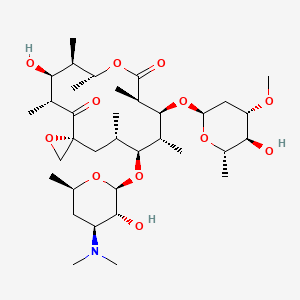Drug Information
Drug (ID: DG00383) and It's Reported Resistant Information
| Name |
Matromycin
|
||||
|---|---|---|---|---|---|
| Synonyms |
Oleandomycin; Amimycin; Matromycin; Romicil; Landomycin; 3922-90-5; UNII-P8ZQ646136; CHEBI:16869; P8ZQ646136; PA 775; Oleandomicina; Oleandomycine; Oleandomycinum; Oleandomycin [INN]; Antibiotic PA-105; Oleandomycine [French]; Oleandomycin [INN:BAN]; Oleandomycine [INN-French]; Oleandomycinum [INN-Latin]; Oleandomicina [INN-Spanish]; HSDB 7442; EINECS 223-495-7; AI3-50163; Prestwick3_000152; SCHEMBL3717; BSPBio_000284; BPBio1_000314; CHEMBL606258; Oleandomycin (chloroform solvate); BDBM234401; LMPK04000007; ZINC85432018; DB11442; NCGC00179617-01; 12-((2,6-Didesoxy-3-O-methyl-alpha-K-arabino-hexopyranosyl)oxy)-8-hydroxy-5,7,8,11,13,15-hexamethyl-14-((3,4,6-tridesoxy-3-dimethylamino-beta-D-xylo-hexopyranosyl)oxy)-1,9-dioxaspiro(2.13)hexadecan-4,10-dion; E704; HY-116010; AB00513809; CS-0063452; C01946; (3R,5R,6S,7R,8R,11R,12S,13R,14S,15S)-6-hydroxy-5,7,8,11,13,15-hexamethyl-4,10-dioxo-14-[3,4,6-trideoxy-3-(dimethylamino)-beta-D-xylo-hexopyranosyloxy]-1,9-dioxaspiro[2.13]hexadec-12-yl 2,6-dideoxy-3-O-methyl-alpha-L-arabino-hexopyranoside
Click to Show/Hide
|
||||
| Structure |

|
||||
| Drug Resistance Disease(s) |
Disease(s) with Clinically Reported Resistance for This Drug
(2 diseases)
[1]
[2]
Disease(s) with Resistance Information Validated by in-vivo Model for This Drug
(1 diseases)
[3]
|
||||
| Click to Show/Hide the Molecular Information and External Link(s) of This Drug | |||||
| Formula |
C35H61NO12
|
||||
| IsoSMILES |
C[C@@H]1C[C@@H]([C@H]([C@@H](O1)O[C@H]2[C@H](C[C@@]3(CO3)C(=O)[C@@H]([C@H]([C@H]([C@H](OC(=O)[C@@H]([C@H]([C@@H]2C)O[C@H]4C[C@@H]([C@H]([C@@H](O4)C)O)OC)C)C)C)O)C)C)O)N(C)C
|
||||
| InChI |
1S/C35H61NO12/c1-16-14-35(15-43-35)32(40)19(4)27(37)18(3)22(7)46-33(41)21(6)31(47-26-13-25(42-11)28(38)23(8)45-26)20(5)30(16)48-34-29(39)24(36(9)10)12-17(2)44-34/h16-31,34,37-39H,12-15H2,1-11H3/t16-,17+,18-,19+,20+,21+,22+,23-,24-,25-,26-,27-,28-,29+,30-,31-,34-,35+/m0/s1
|
||||
| InChIKey |
RZPAKFUAFGMUPI-QESOVKLGSA-N
|
||||
| PubChem CID | |||||
| INTEDE ID | |||||
| DrugBank ID | |||||
Type(s) of Resistant Mechanism of This Drug
Drug Resistance Data Categorized by Their Corresponding Diseases
ICD-01: Infectious/parasitic diseases
| Drug Resistance Data Categorized by Their Corresponding Mechanisms | ||||
|
|
||||
| Key Molecule: 23S ribosomal RNA methyltransferase Erm36 (ERM36) | [2] | |||
| Molecule Alteration | Expression | Inherence |
||
| Resistant Disease | Micrococcus luteus infection [ICD-11: 1A00-1C4Z] | |||
| Experimental Note | Identified from the Human Clinical Data | |||
| In Vitro Model | Micrococcus luteus MAW843 | 1270 | ||
| Experiment for Molecule Alteration |
Sequence analysis | |||
| Experiment for Drug Resistance |
Agar diffusion test assay | |||
| Mechanism Description | Erm(36) was most related (about 52-54% identity) to erythromycin-resistance proteins found in high-G+C Gram-positive bacteria and lead to drug resistance. | |||
| Drug Resistance Data Categorized by Their Corresponding Mechanisms | ||||
|
|
||||
| Key Molecule: Oleandomycin glycosyltransferase oleI (OLEL) | [1] | |||
| Molecule Alteration | Expression | Inherence |
||
| Resistant Disease | Streptomyces infection [ICD-11: 1C43.6] | |||
| Experimental Note | Identified from the Human Clinical Data | |||
| In Vitro Model | Escherichia coli C41(DE3) | 469008 | ||
| Experiment for Molecule Alteration |
Linked enzyme activity assay | |||
| Experiment for Drug Resistance |
MIC assay | |||
| Mechanism Description | Glycosylation of macrolide antibiotics confers host cell immunity from endogenous and exogenous agents. The Streptomyces antibioticus glycosyltransferases, OleI, glycosylate and inactivate oleandomycin. | |||
| Key Molecule: srmA open reading frame gimA (GIMA) | [4] | |||
| Molecule Alteration | Expression | Inherence |
||
| Resistant Disease | Streptomyces ambbyaciens infection [ICD-11: 1C43.0] | |||
| Experimental Note | Discovered Using In-vivo Testing Model | |||
| In Vitro Model | Escherichia coli | 668369 | ||
| Escherichia coli strain S17.1 | 1227813 | |||
| Micrococcus luteus strain Cgr | 1270 | |||
| Micrococcus luteus strain DSM1790 | 1270 | |||
| Streptomyces ambofaciens strain ATCC 23877 | 278992 | |||
| Streptomyces ambofaciens strain OS41.99 | 1954 | |||
| Streptomyces ambofaciens strain OS41.99NP | 1954 | |||
| Streptomyces ambofaciens strain OS81 | 1954 | |||
| Streptomyces lividans strain OS456 | 1916 | |||
| Experiment for Molecule Alteration |
DNA sequencing assay | |||
| Experiment for Drug Resistance |
Observation of growth inhibition zones assay | |||
| Mechanism Description | With UDP-[14C]glucose as the cofactor, crude S30 extracts from OS456(pOS41.90) were tested on various macrolides. Among those, chalcomycin was the most active substrate. Methymycin, tylosin, pikromycin, and rosaramicin were four of the best substrates. Oleandomycin, josamycin, and carbomycin were glycosylated to a lesser extent. Macrolides that were found to be as poor substrates of GimA as lankamycin were erythromycin and angolamycin. Spiramycin was also a very poor substrate. | |||
|
|
||||
| Key Molecule: ATP-binding protein (ABP) | [5] | |||
| Molecule Alteration | Expression | Inherence |
||
| Resistant Disease | Streptomyces antibioticus infection [ICD-11: 1C43.1] | |||
| Experimental Note | Discovered Using In-vivo Testing Model | |||
| In Vitro Model | Streptomyces antibioticus strain | 1890 | ||
| Experiment for Molecule Alteration |
Fluorescence measurements assay | |||
| Mechanism Description | The OleB protein ofStreptomyces antibioticus, oleandomycin (OM) producer, constitutes an ATP-binding cassette transporter containing two nucleotide-binding domains and is involved in OM resistance and its secretion in this producer strain. | |||
| Key Molecule: ATP-binding protein (ABP) | [3] | |||
| Molecule Alteration | Expression | Inherence |
||
| Resistant Disease | Streptomyces antibioticus infection [ICD-11: 1C43.1] | |||
| Experimental Note | Discovered Using In-vivo Testing Model | |||
| In Vitro Model | Streptomyces albus J1074 | 457425 | ||
| Streptomyces lividans strain Tk21 | 1916 | |||
| Escherichia coli strain ED8767 | 562 | |||
| Escherichia coli strain TGI | 83333 | |||
| Streptomyces antibioticu strain ATCC 11891 | 1890 | |||
| Experiment for Molecule Alteration |
DNA hybridizations assay | |||
| Mechanism Description | Three different DNA fragments of an oleandomycin producer, Streptomyces antibioticus, conferring oleandomycin resistance were cloned in plasmid pIJ702 and expressed in Streptomyces lividans and in Streptomyces albus. These oleandomycin resistance determinants were designated as oleA (pOR400), oleB (pOR501) and oleC (pOR800). The oleC (orf4) gene product had a hydrophilic profile and showed important similarity with proteins containing typical ATP-binding domains characteristic of the ABC-transporter superfamily and involved in membrane transport and, particularly, with several genes conferring resistance to various macrolide antibiotics and anticancer drugs. | |||
References
If you find any error in data or bug in web service, please kindly report it to Dr. Sun and Dr. Zhang.
